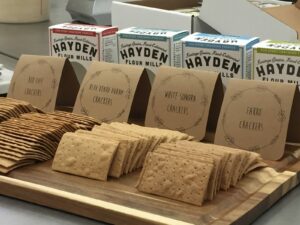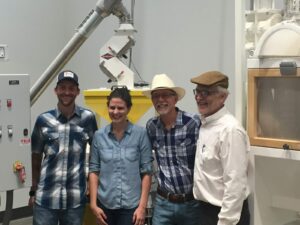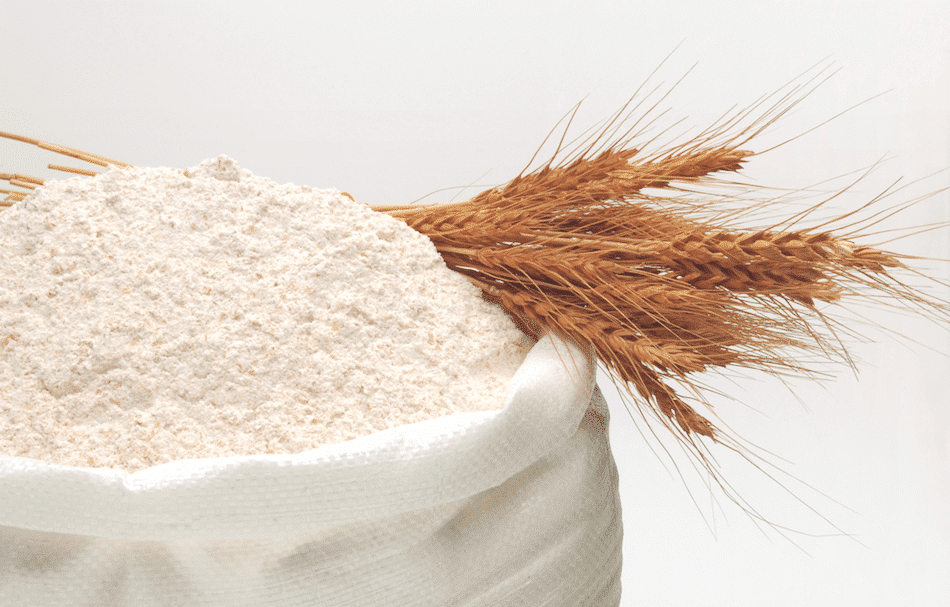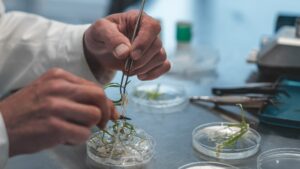An unlikely partnership goes to extraordinary efforts to bring about the heritage and ancient grain movement in Arizona, adding flavor to the millennial diet.
All Jeff Zimmerman wanted was a local farmer to work with him, growing 30 acres of ancient grains. At the time, Zimmerman had been working for CVS Health as a process manager and before that as a quality systems manager for Intel. For three years Zimmerman spoke with farmers and pitched his idea of growing ancient and heritage grains and reviving the old Hayden Flour Mill in Queen Creek, Ariz.
One day, out of desperation but with a glimmer of hope, he approached a friend from college, Steve Sossaman, whose family homesteaded there in 1919. Sossaman listened to his friend who was visibly worn from rejection after rejection, and simply asked “how much land do you think you need?” Thirty acres, said Zimmerman. Sossaman was skeptical at the time but willing to give it a try; it was only 30 acres. After all, he farms year-round, and his family through the years had grown everything from vegetables to cotton and corn to alfalfa. Sossaman himself had been farming for 40 years, so he was ready to try something a bit out of the ordinary.
For Zimmerman and Sossaman, that was the beginning of what they will admittingly call a bleeding-edge business venture and partnership — growing wheat varieties that yield four to five times less than traditional varieties; adding food-grade processing, cleaning and sorting equipment and breathing new life into a rundown, dilapidated flour mill on the outskirts of Phoenix.
Extraordinary Vision

Zimmerman was focused on reviving an old flour mill that began operation in 1870, while Sossaman was focused on sourcing and learning to grow these heritage and ancient grains.
For Zimmerman, it is all about bringing taste and flavor back to bread and pasta.
That first year, Sossaman grew 30 acres with three different varieties of wheat: White Sonora, Red Fife and Farro.
“As we did it that first year in 2011, I found that the grains came from Mesopotamia and were more than 6,000 years old. The newest is from 300 years ago,” Sossaman says. “White Sonora is what the wheat wafers are made from for communion, Red Fife came from Canada and Farro is Jesus’ wheat. All these grains have these amazing histories that go with them.”
But it’s not just the history that’s intriguing; flavor is the driving force.
“Chefs are going to love it, and it fits perfectly with the millennial diet of beer, bread, whiskey and pizza,” Sossaman says, who hired his son-and-law Travis Tolmachoff, a chef by training, to help in the new venture.
In fact, that’s who Sossaman turns to when making decisions, the millennials in his family and on the farm. If they’re not into it, then I don’t see it as a good move going forward, he says — two of his daughters work at Hayden Flour Mills.
Sossaman explains the flavor of today’s wheat has been lost through hybridization and the shortening, or dwarfing, of plants to increase yields during a time of hunger and war. It was needed then, he says, but today consumers want flavor and they want to connect with their food.
In shortening the height of the wheat plant, breeders also dwarfed the root system, which Sossaman says was pulling up mineral from the soil and adding different flavors to the grain.
For traditional wheat, Sossaman says the root system is maybe 3-4 feet deep. For the ancient grains he is growing, the root systems are going down as much as 12 feet into the soil.
Seed Sourcing
However, acquiring the seed to grow these ancient grains has not been easy. Sossaman says he’s talked with people from all over the country and in Europe trying to source some of these seeds.
“You hear of a guy who might have some, so you pick up the phone and call. He doesn’t have any but he knows someone who might and connects you with their contact information,” Sossaman shares. “It’s easy to spend a great deal of time just tracking this stuff down, and some people have a hoarding mentality.
“We are open source,” Sossaman says. “I believe if you really want to preserve these ancient seeds, then getting them into the hands of as many people as possible just makes sense.”
Growing and Processing
In the first five years, Sossaman experimented with these heritage and ancient grains in different types of growing systems and what he found works best is a set up that marries drip irrigation with vertical tillage, but without the actual irrigation.
“By adopting this method, I’ve been able to save about 40 percent in fuel and labor,” he says. “The system I’ve got in place uses less water (less than half) and less fertilizer (only cow manure) — something that’s been attractive as we’ve hired a few contract growers.
“You’ve got to have something that’s attractive when yields are one-fifth of a normal wheat crop, plus we charge buyers a premium price so we can take care of our growers.”
Sossaman grows Farro (Triticum dicoccon), a chewy ancient wheat that once flourished in the Middle East. Another heirloom wheat, Red Fife, is especially suited for bread baking. Two cultivars of barley grow on the farm, Black Nile from Egypt and Tibetan Purple, both of which do well in the Sonoran Desert because they originated in harsh climates. Three cultivars of durum wheat on the property provide semolina for making pasta.
Once the grain is harvested, it’s brought into the warehouse where Sossaman has invested more than $2 million and sourced equipment from five countries to get the best pieces for a one-of-a-kind food-grade processing facility.

“People around the country have different parts of this system, but not all these pieces put together like this,” Sossaman says.
First the grain is sent through a clipper, which gets rid of chaff, and then to a gravity table, which is followed by a destoner with magnets throughout it to catch any metal. It also goes through a Meyer color sorter.
“For the White Sonora, hard reds and purple grains, we are able to set up a color spectrum that sorts out exactly what we want for pure, food-grade wheat,” explains Tolmachoff, who did all the research and designed the system.
Then there’s a dehuller to get the husks off the grain, allowing them to sell hulled Farro. Finally, there’s a preservation system in which oxygen is pulled out of the storage bags and carbon dioxide is pumped in.
“We did this because we may only grow a specific variety one year out of five, so we needed a way to keep the grain’s quality for an extended period of time,” says Tolmachoff, who just three years ago never dreamed he’d be working on a farm.
“It’s been a good transition because with Steve’s farming background and mine as a chef, I know what they are looking for and I can speak the end-user’s language,” he adds.
Sossaman sells the wheat mostly in 1-ton totes, and he says some microbreweries will order in 50-pound bags for .60 to $1.25 per pound. Sossaman’s biggest customer: Zimmerman and his daughter Emma at Hayden Flour Mills.
Milling
“The grains that we mill are those grown prior to the 1950s,” says Zimmerman, who got his first batch of White Sonora to mill in 2011. “These are known as heritage grains, similar to an heirloom tomato. We also mill ancient grains and these are the grains that go back to 10,000 years ago.”
Hayden Flour Mills sifts, bags, labels and ships flour to customers. One of those customers is Chris Bianco, who’s famous around the world for his pizza.
Every week, Bianco orders 50 pounds of semolina for his pasta from Hayden Flour Mills and that’s delivered fresh every Friday.
“We’ve come such a long way in the heritage grain movement in Arizona, in just the past three to four years,” Zimmerman says.
While it was his passion, he says it couldn’t be successful without chefs like Bianco who put a great deal of integrity into their ingredients, and farmers such as Sossaman who are willing to take a risk.
“The past five to seven years have been the most rewarding because we actually get to see our product and what happens on our farm go from seed to plate,” Sossaman says.












